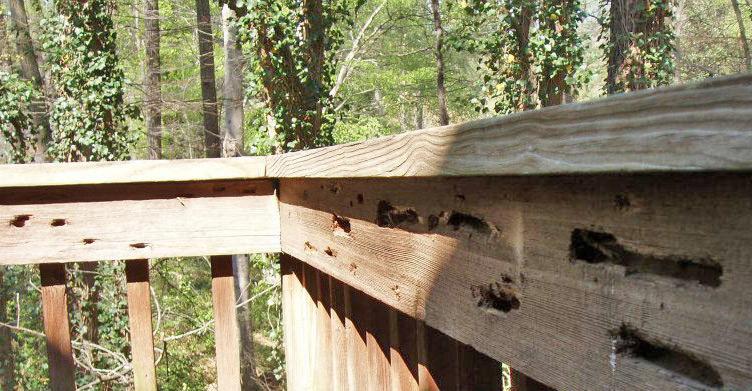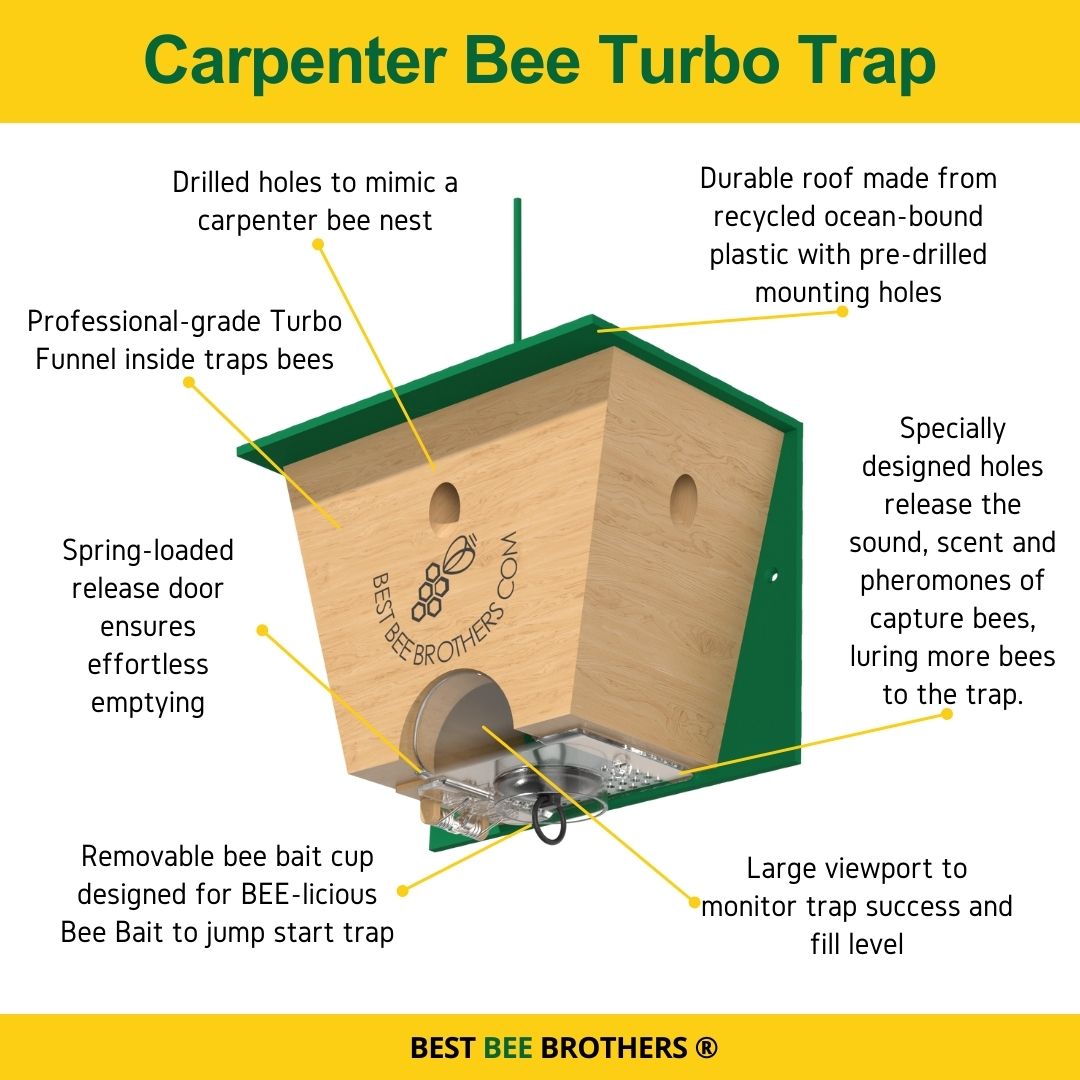What Does a Carpenter Bee Infestation Look Like?
In the early months of spring, it is common to see a myriad of tiny critters emerge from long hibernation or their overwinter slumber. In this regard, carpenter bees are no exception. While often mistaken for their highly active pollinator cousin, the bumble bee, carpenter bees are actually quite easy to identify once you know what to look for.

The first physical attribute that can help you to ID a carpenter bee is its relative size. Carpenter bees are, on the whole, significantly larger than bumble bees. Another important characteristic is the carpenter bee’s lack of the distinctive striped abdomen. Bumble bees have a furry yellow-and-black-striped abdomen, giving them a soft, plush appearance. Carpenter bees, in contrast, have a yellow thorax but a flat, shiny black abdomen.
Nesting behavior can also help you tell the two species of bees apart. While bumble bees prefer the safety of an underground home, carpenter bees (as their name suggests) bore small holes into wood surfaces to lay their eggs, usually about ½ inch in diameter.
In this way, carpenter bees are very easy to spot because their homes are typically – and unfortunately – in the roofing, siding, eaves, porches and decks of people’s homes. When inspecting for carpenter bee infestations, you’ll want to pay special attention to the small nooks and crannies of your outdoor wood surfaces. Remember, these little bees are talented at chewing through wood and will create very neat, cylindrical holes. Carpenter bees are particularly attracted to untreated, weathered wood species that are less dense, such as redwood, cedar, cypress and pine.1
Signs of a Carpenter Bee Infestation
There are a number of clues that your home may be the new lodging for a family of carpenter bees. The first and most obvious is a series of ½-inch holes bored into the wooden surfaces of your home.2 Though not as destructive as termites, carpenter bees are fastidious in their work and show great attention to detail in the size and cleanliness of their boring.
Another telltale sign of a carpenter bee infestation is the presence of sawdust in areas around your home where no construction or maintenance has taken place. Naturally, as carpenter bees burrow into the structure of a wooden surface, they must remove the excess wood pulp and sawdust. This can leave a fairly obvious trail of where these bees have been the most active.

Bee excrement around these areas may be visible as well. Carpenter bee excrement stains wood and is very difficult to remove, even with the aid of a power washer. So if you notice yellow-brown stains on your wooden surfaces, this could be indicative of carpenter bee activity.
Finally, the most obvious sign of a carpenter bee infestation is the presence of multiple carpenter bees in an area of small square footage. Unlike other species, such as honeybees, carpenter bees are solitary bees and do not nest in colonies or large honeycomb structures. Instead, each carpenter bee unit operates as its own independent group.
In this way, male carpenter bees (which are actually harmless since they possess no stinger) act as the protectors of the home mid-construction and will fly aggressively in front of animals, birds and even humans in an attempt to intimidate potential threats from invading. The presence of one or more male carpenter bees flying erratically around your head space is usually a sign that you have a carpenter bee infestation on your hands.

Carpenter Bee Infestation Removal
Given the recent awareness of the decline in global bee populations, and the important role they play in pollination, it’s understandable to feel hesitant in taking action against bees – even the ones that are a nuisance. That said, carpenter bees are more than just a mild bother. If left untreated, they can cause serious damage to your home, boring deeper and deeper galleries (tunnels) into the sides, roofing and eaves of your home. In some cases, there have even been reports of porches collapsing under the fervent activity of untreated carpenter bee infestations.
So what can you do about it?
-
The first treatment option for carpenter bee infestations is to simply treat any and all wood siding on your home, including the porch, eaves, roof and deck. This could include the simple removal of rotting boards of timber or a fresh coat of paint for the spring. Remember, carpenter bees prefer untreated wood.
-
If you completed the above step and still find that you have pesky carpenter bees drilling holes into your home, it’s time to take further action. At Best Bee Brothers, we have three products to help you mitigate carpenter bee damage. The first is our Citrus Spray: Carpenter Bee Repellent. This combination of natural citrus oils (lemongrass and citronella) acts as an organic deterrent, since carpenter bees hate the smell of citrus!
-
If that doesn’t keep them away, or your carpenter bee infestation is more serious, we recommend investing in our Carpenter Bee Turbo Trap or Pine Wood Trap. Both products mimic the natural nesting areas of carpenter bees using soft wood that is perfect for drilling into.
-
Whether you decide to go with the natural citrus spray or a Best Bee Brothers trap, it’s imperative that you plug any previously bored carpenter bee holes with wood putty or other sealants.3 Bee Bee Brother offers premade Wooden Corks perfectly suited to plug existing carpenter bee holes. If not, you can be fairly certain that next spring there will be a very grateful family of carpenter bees that are happy you’ve saved them the work of having to chew some new holes.
By taking action early on in the spring months, you can rest easy knowing that your home, your family and your summer are secure. Don’t worry, Best Bee Brothers has your back!
- Michael F. Potter, “Carpenter Bees,” College of Agriculture, Food and Environment, University of Kentucky, September 7, 2018, https://entomology.ca.uky.edu/ef611.
- Timothy J. Gibb, “Carpenter Bees,” Household & Structural Insects, Purdue University Extension – Entomology, March 2018, https://extension.entm.purdue.edu/publications/E-252/E-252.html.
- Michael F. Potter, “Carpenter Bees,” College of Agriculture, Food and Environment, University of Kentucky, September 7, 2018, https://entomology.ca.uky.edu/ef61.









1 comment
Joseph Campisi
Have four Best carpenter Bee Traps up ( one near the front door and three on the side deck attached to the house). Two of the traps on the deck have not caught any bees. Should I move them ??
Leave a comment
All comments are moderated before being published.
This site is protected by hCaptcha and the hCaptcha Privacy Policy and Terms of Service apply.